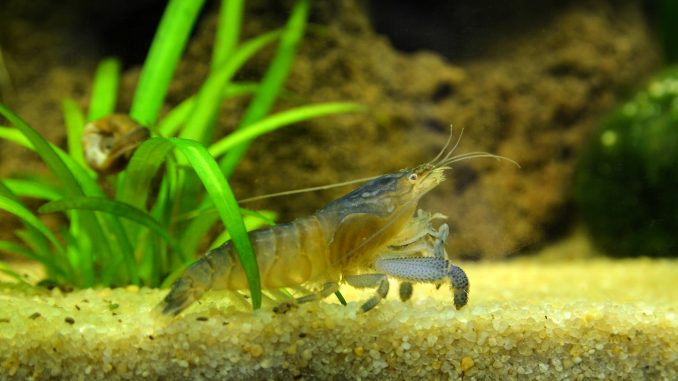
Of all the freshwater shrimp, the Vampire Shrimp is arguably the most fascinating. This shrimp has the ability to change colors, and it lives longer than many other varieties of freshwater shrimp. Although their usual size is 2-3 inches (5.1-7.6 cm), some Vampire Shrimp grow up to 6 inches (15.2 cm) have been reported!
These shrimp are also a little broader than other freshwater shrimp–they look chunkier. For the variety, they provide in the appearance of your tank, and the fact that they are super peaceful tankmates, you might choose them to provide a burst of life to your community tank.
In this article, we’ll cover all you need to know about caring for Vampire Shrimp, including information about their behavior, diet, tank needs, and suitable tankmates.
TABLE OF CONTENTS
Vampire Shrimp Facts & Overview
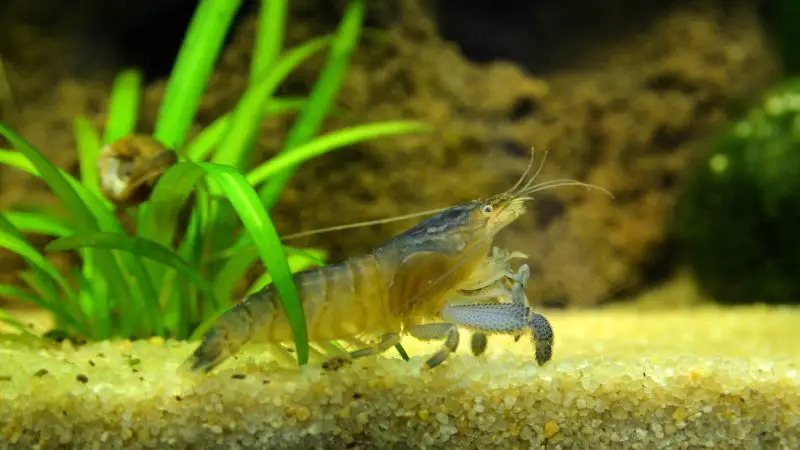
| Category | Rating |
| Care Level: | Easy to medium |
| Temperament: | Peaceful |
| Color Form: | Varied and color changing |
| Lifespan: | 5 years |
| Size: | 2-3 inches |
| Diet: | Detritivore/omnivore |
| Family: | Atyidae |
| Minimum Tank Size: | 15 gallons |
| Tank Set-Up: | Freshwater with plants and rocks |
| Compatibility: | Peaceful community |
The beautiful, color-changing Vampire Shrimp hail from South America and Western Africa. The peaceful creatures’ scientific name Atya gabonensis, have a number of different monikers, including Viper Shrimp, African Fan Shrimp, African Filter Shrimp, Giant African Fan Shrimp, Giant African Filter Shrimp, and Gabon Shrimp.
It’s funny to associate the name Vampire or Viper with such a peaceful and unassuming crustacean, but their name likely comes from their nocturnal nature as well as the little spikes on their feet that resemble fangs.
Vampire Shrimp are a particular type of filter feeders and eat the granular particles and microorganisms from the water column. They have tiny hands that look like fans, and they use them to collect food traveling through the water current; thus, they are known as fan feeders. They play well in the sandbox with other shrimp, and especially enjoy the company of Bamboo Shrimp.
The rare Vampire Shrimp species is a good choice for a planted or nano tank. They need places to hide and are pretty shy, preferring to appear at night and ride the currents of your home aquarium.
One great aspect of Vampire Shrimp is that they are easy to care for; additionally, they are also peaceful tank inhabitants. Whether they are alone in the aquarium or surrounded by other peaceful creatures, they are content.
Unfortunately, the lovely Vampire Shrimp is endangered and on the threatened species list; therefore, they are harvested only in small quantities in West Africa, particularly in Northern Nigeria.
Typical Behavior
Because Vampire Shrimp are filter feeders, they need a stronger current to collect food and, therefore, hang out in the area of your aquarium with the highest flow. There, they use their fanned hands to grab food from the water, whether it be microorganisms, other food particles, or plant matter.
When they find their sweet spot in the current, they will stay there to gather their bounty. But when they want to eat what they’ve collected, they move to the bottom of the tank near their hiding places.
One thing that is different from other dwarf shrimp species is that Vampire Shrimp require warmer water conditions, higher oxygen levels, and, as mentioned, a stronger current.
They have extremely shy personalities, and so need lots of hiding places to help them feel safe and unstressed. Although they are shy, they are also social and enjoy feeding together in groups. Even so, be sure to provide cover and hiding spots because they do require alone time.
In fact, it’s recommended that you not do cleaning and maintenance of your aquarium during the rare occasions that they come out to eat or socialize–they are so skittish that they are likely to hide for days after being scared by your movements.
Their breeding behavior is peculiar, and it’s nearly impossible to breed them in captivity because they need both brackish and freshwater conditions. Vampire Shrimp fry need these varying water conditions as they advance through different larval planktonic periods.
Appearance
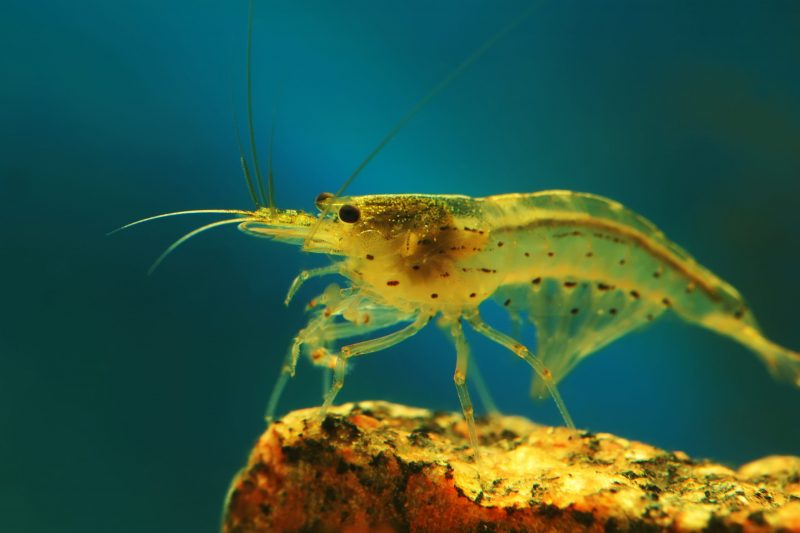
Unlike most dwarf shrimp that are an inch or less (2-3 cm), Vampire Shrimp are giant in comparison, at about 2-3 inches, or 5.1-7.6 cm. And as we mentioned earlier, some Vampire Shrimp can get up to 6 inches (15.2 cm) long, towering over other dwarf shrimp.
Perhaps the closest in size comparison is the Bamboo Shrimp, which is also about 2-3 inches, or 5.1 to 7.6 cm. Bamboo Shrimp and Vampire Shrimp are friendly with each other, but sadly, Bamboo Shrimp have a much shorter lifespan (1-2 years), while Vampire Shrimp live to 5 years and possibly longer.
You can also distinguish Vampire Shrimp from other shrimp by their boxier appearance. They are stockier than other shrimp, which look thinner in comparison to Vampire Shrimp.
On the sides of their legs, Vampire Shrimp have pointy bumps that help them grip and anchor themselves in strong currents.
Because they are nocturnal creatures, they have long antennae that help them find their way around in the aquarium.
These long slender antennae are found on the top of their heads; perhaps these feelers come in handy when they move around at night.
Color Features
Vampire Shrimp come in a range of colors and hues. You will see myriad shades of blue-grey, cream, pink, green, and even reddish brown. You’ll notice that their color changes when they molt and can look different depending on the substrate color that you use.
As they age, their color fades and becomes less vibrant. The maroon and brown color is more common in older Vampire Shrimp.
Distinguishing males and females
Before they are at an adult age, it is impossible to discern males from females. But when they get closer to reproductive maturity, it is easier to see the differences. There are 4 major distinct appearance features in males and females:
- Female Vampire Shrimp are smaller than male Vampire Shrimp
- Abdominal plates of the female Vampire Shrimp are larger at the beginning of the abdomen
- Female shells are deeper and rounder in the abdomen
- The first pair of legs on the male Vampire Shrimp is thicker than the female’s
Molting
About every two months, Vampire Shrimp go through a molting process. A new shell grows under the top shell, and then the outer shell will crack and the Vampire Shrimp sheds that shell.
Like other invertebrates that molt, the new shell is softer, and so it is a dangerous and vulnerable time. You should be careful with maintenance and tank cleaning and wait until after the shrimp have molted.
The hiding places that you lovingly provide for your Vampire Shrimp also come in handy during molting–they will use these spots as protection while the new shell is hardening.
Don’t worry about going in to fish the old shell out of the tank, for the shells provide nutrients and minerals that other aquarium dwellers need. The Vampire Shrimp shells are harder than other shrimp’s (remember the thicker, boxier appearance), so they’re not as commonly ingested as older molten shells. You can remove the shells if they have been in there for a few days with no takers.
Habitat and Tank Conditions
The amount of water needed to house Vampire Shrimp has more to do with their feeding needs than their size. Because they are filter feeders, they need enough water to keep a moderate current flowing through the tank. With a larger tank, you will also get the dimensions needed to maintain the correct water flow.
For substrate, choose rock, gravel, or sand, with the latter being preferable since they do consume some of the sand. That fact may be due to the sand helping with their digestion, and it is also closest to the conditions of their natural habitat in South America and West Africa.
Additionally, although Vampire Shrimp are large for aquarium shrimp, they are still very small creatures–if you are using gravel or rocks as substrate, they may damage their fans as they scavenge the aquarium floor.
Decorations and planting
First of all, you should provide the shy Vampire Shrimp with plenty of places to retreat to; they really need lots of hiding spots, particularly when they are molting. Provide rocks, store-bought decorations, and even a sponge filter, which will all provide places of refuge and also give them a spot to eat the food they have collected with their fans.
Having a well-planted tank is also beneficial for Vampire Shrimp. The plant sheds nutrients and decay produces detritus that are both necessary sources of nutrition. Additionally, the plants themselves offer needed to cover, serving as additional hiding places.
Although using plastic plants may provide cover for your Vampire Shrimp, they will not produce nutrients that live plants will. Live plants create more mess, but they also provide a valuable source of nutrition.
Also, as you’ll discover when we discuss the diet of Vampire Shrimp, and the water conditions in the following section, Vampire Shrimp need a certain amount of …well, gunk… to access the nutrition that they need. They are big algae and detritus consumers, so the live plants contribute to optimal tank conditions for your Vampire Shrimp.
Water Conditions
Vampire Shrimp can tolerate some variation in water parameters, but you should always maintain stability with the conditions that you initially provide; they do not tolerate changes in conditions well. If you introduce them to water that is 82° F (27.8° C), maintain that temperature even though the range is 75° – 84° F (24° – 28.8° C).
Appropriate water ranges for Vampire Shrimp are similar to appropriate ranges for tropical fish if you are planning to curate a community tank.
Acceptable water parameters for Vampire Shrimp:
- Temperature: 75° – 84° F (24° – 28.8° C)
- pH: 6.5 – 7.5
- KH: 3 – 10 dKH
- Ammonia: 00 ppm
- Nitrite: 00 ppm
- Nitrate: 20 ppm
As we mentioned a few times in relation to their feeding, Vampire Shrimp require a moderate water current in order to feed off the filter. The proper current can be achieved by adding a second pump in the lower section of the tank.
Vampire Shrimp also need water that is rich in oxygen, and like their water on the hard side of the spectrum. Although they are good tank mates with virtually every species of dwarf shrimp, they need warmer water than other dwarf shrimp, so if you are housing them together, you will need to hit the high end of the dwarf shrimp range and the low end of the Vampire Shrimp range, which is 77° F, or 25° C.
What Size Aquarium Do They Need?
15 gallons (about 70 liters) is the minimum tank size we recommend for Vampire Shrimp. Although they are small, they do require a certain amount of space to accommodate their fan feeding. With the 15-gallon tank, you can fit 4 to 5 shrimp.
Even though they are shy, they are social creatures and don’t mind sharing tank space; it is more a matter of what size tank will give them sufficient room for eating.
How Many Can Be Kept Per Gallon?
You should allow 3 to 4 gallons for each Vampire Shrimp. Looking at the minimum tank size of 15 gallons, you should plan for 4 to 5 Vampire Shrimp.
Tank Mates
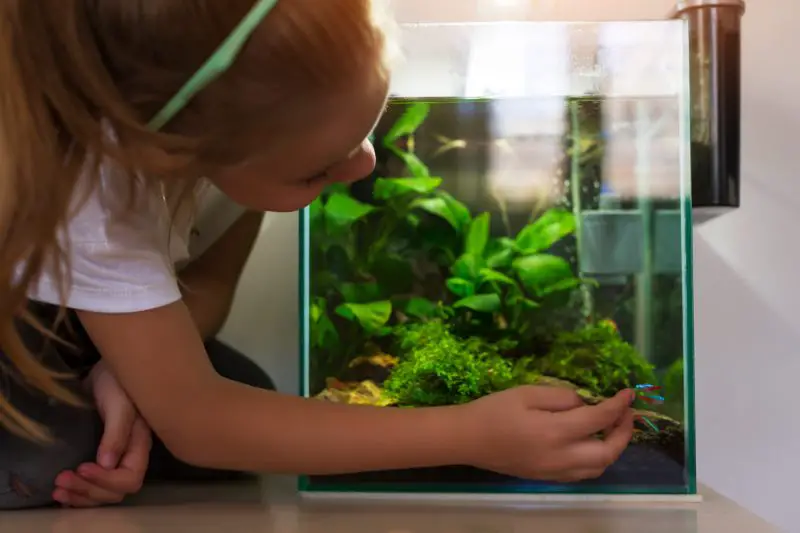
Vampire Shrimp do well with other peaceful freshwater shrimp, snails, and peaceful fish. You want to avoid them sharing a tank with fish that might see them as a second breakfast.
As Vampire Shrimp are extremely peaceful, it’s best to put them with other peaceful neighbors–remember that they are incredibly shy and feel threatened easily. Stressed-out shrimp don’t live as long, lose their vibrant color, and are more likely to become sick, so you want to surround them with tank mates that keep the peace.
Appropriate tank mates for Vampire Shrimp:
- Amano Shrimp
- Bamboo Shrimp
- Blue Tiger Shrimp
- Blue Velvet Shrimp
- Ghost Shrimp
- Malawa Shrimp
- Red Cherry Shrimp
- Red Nose Shrimp
- Snowball Shrimp
- Tangerine Tiger Shrimp
- Gold Inca Snails
- Ivory Snails
- Japanese Trapdoor Snails
- Malaysian Trumpet Snails
- Mystery Snails
- Nerite Snails
- Ramshorn Snails
- White Wizard Snails
These fish are also good tankmates for the Vampire Shrimp, but they are likely to eat other dwarf shrimp, so if you have picked any of the shrimp on the above list, you should skip these fish:
- Cherry Barbs
- Danios
- Dwarf Chain Loaches
- Guppies
- Sawbwa Resplendens
- Strawberry Boraras
Inappropriate tank mates for Vampire Shrimp:
Keeping Vampire Shrimp Together
Vampire Shrimp can be kept on their own, but also do quite well in a tank with other Vampire Shrimp.
Diet
Vampire Shrimp are scavengers and filter feeders, but they are not very aggressive scavengers, so make sure to feed them at night if they are in a tank with other fish. If you feed them during the day while they are hiding, they might not get enough food.
They use their fans to filter food and nutrients from the water column and use the same fans to collect food from the substrate. The substrate is a secondary source of food, and if you often see them fanning for food there, try feeding them a little more; they may be hungry and not getting enough food from the water current.
In their natural habitat in South America and West Africa, the diet of the Vampire Shrimp includes algae (including diatoms), detritus (dead organic particles), and insect parts. This diet is fairly easy to recreate in your home tank, where they will munch on microorganisms in the water current, plant matter, leftover fish food, and algae that builds up in the tank.
You can supplement their diet with:
- algae wafers
- dried nettle leaves
- fish pellets
- flake food
- phytoplankton
- shrimp pellets
- spinach powder
- zooplankton
All these additions must be ground very finely so that the Vampire Shrimp can consume it–if it is not in powder form, they will not be able to handle the size and texture.
If you drop the powder into the water current, the Vampire Shrimp will be able to catch it in their fans. You could also combine these foods in powder form to provide a full spectrum of nutrition.
You can also provide nutrition by adding plants and greenery to your tank. If you add Mangrove leaves, nutrients and food sources for the Vampire Shrimp are released when the leaves decompose.
Care
Like other aquarium shrimp, copper is kryptonite for Vampire Shrimp–they can not tolerate it at all and it could be fatal to them. As with any aquarium resident, maintaining peak water conditions is the single most important thing you can do to ensure longevity and quality of life in your Vampire Shrimp.
Pro Tip: Peak water conditions are species-specific. We refer to water parameters, which vary greatly, and cleanliness. While some aquarium dwellers require pristine water, Vampire Shrimp actually need water that is slightly dirty so that they can feed off the algae and microorganisms in the water.
It’s also important to remember that water needs may vary among different residents of your home aquarium, so you must be deliberate and mindful when curating your tank.
Test water regularly and maintain appropriate levels, limiting ammonia, nitrate, and nitrite levels. Watch feeding levels, as more food creates more waste and equals a dirtier tank. You should also perform partial water changes on a regular basis.
Breeding
As we discussed in the behavior section of this article, it’s essentially impossible to recreate the conditions needed to breed Vampire Shrimp in captivity. Any Vampire Shrimp you buy will have been caught in the wild.
Vampire Shrimp larvae require brackish water, and the larvae stage is quite long–about 3 months. Although there are other aquarium inhabitants that you can try to breed with a separate spawning tank that has brackish water, we do not recommend trying to breed Vampire Shrimp due to the fact that the chances of survival for the baby shrimp are incredibly low.
Therefore, we’ll focus on fun facts about breeding practices of Vampire Shrimp in the wild:
- Depending on the size of the Vampire Shrimp, females lay anywhere from 850 to more than 12,000 eggs
- Breeding takes place after molting since fertilization is possible only when the shell is soft
- Most breeding happens in rainy seasons
- The female Vampire Shrimp holds her eggs for 3 to 4 weeks; once they hatch, they have to get to saltwater immediately
- Adult Vampire Shrimp can kill their own larvae if they catch them in their fans
- Baby Vampire Shrimp move to freshwater at about 4 months of age
Again, the process of moving the larvae from brackish to salt to freshwater is very delicate, and attempting to breed Vampire Shrimp at home is not recommended.
Are Vampire Shrimp Suitable for Your Aquarium?
Whether you are planning a nano tank with one Vampire Shrimp or adding multiples to a community tank, you’ll enjoy having these unusual shrimp in your aquarium. Their color changes are fascinating to follow, and you’ll have fun watching them hold their own against a current while they fan for food.
These are peaceful creatures whose appearance is far more intimidating than their actual personality.
Are Vampire Shrimp your favorite community tank member? Let us know why in the comments below…
FAQ
What is the difference between Vampire Shrimp and Bamboo Shrimp?
That’s a great question, since Bamboo Shrimp and Vampire Shrimp are friendly if they are in the same tank, and they share a number of similar characteristics.
Some similarities:
- Both are fan feeders
- Both are peaceful tankmates
- Both are about 2-3 inches (5.1-7.6 cm) in size (although Vampire Shrimp can reach up to 6 inches (15.2 cm)
- Both have a relatively high mortality rate when being introduced into a new tank
Some differences:
- Vampire Shrimp have more color variation, while Bamboo Shrimp are mostly reddish-brown
- Bamboo Shrimp are thinner, while Vampire Shrimp are thicker and boxier
- Vampire Shrimp have a harder shell, while the molted shell of the Bamboo Shrimp is more likely to be eaten
- Vampire Shrimp can live up to 5 years, while Bamboo Shrimp have a lifespan of 1-2 years
- Vampire Shrimp are endangered while Bamboo Shrimp are not
Check out my article on Bamboo Shrimp if you’re interested in learning more about them.
Why is my Vampire Shrimp only eating from the bottom substrate and not from the water current?
Thanks for the question! There is a possibility that your Vampire Shrimp are hungry. Although it is normal for them to fan food off the substrate, it should only be a secondary source of nutrition.
It sounds like your Vampire Shrimp are not eating from the water current filter at all, which indicates that they are not getting the nutrition they need. Here are a few things that could be happening and how to remedy the problem:
- They just don’t have enough food–try adding more food to their tank
- The supplemental food you are providing them is too big for them to handle–make sure you are grinding flakes, pellets, and wafers into a powder consistency so that they can collect and digest it
- Other fish in the tank are eating their food–make sure to feed your Vampire Shrimp at night. They hide during the day, so if you’re feeding them during the day, there is a good chance that other fish in the tank is getting to the Vampire Shrimp’s food before they have a chance to eat
What is the average lifespan for Vampire Shrimp?
Vampire Shrimp have an average lifespan of 5 years, and may even live longer than that if they are kept in optimal conditions. This is significantly longer than the lifespan of other aquarium shrimp, who live for 1-2 years.
It should be noted, however, that the time when you introduce Vampire Shrimp to a new tank is a risky time and they have a higher mortality rate during this time. It’s important to quarantine before adding them to a tank and to ensure that water parameters are correct.
Other things that could impact their lifespan are the tank mates that you choose for your Vampire Shrimp. If you choose cichlids, crayfish, goldfish, or any aggressive predatory fish, your Vampire Shrimp is in danger of being eaten.
This danger is even greater when the Vampire Shrimp is molting and has a much softer shell. It would be a shame to lose your Vampire Shrimp before its time, especially considering that they are endangered and hard to come by.
Can I breed Vampire Shrimp at home?
Breeding Vampire Shrimp in captivity has been largely unsuccessful due to the need for varying saltwater, brackish water, and freshwater at different stages of Vampire Shrimp development.
Although you may find some instructions on the World Wide Web for how to breed Vampire Shrimp in captivity, we strongly recommend that you do not try it at home, since the larvae almost never survive to adulthood.

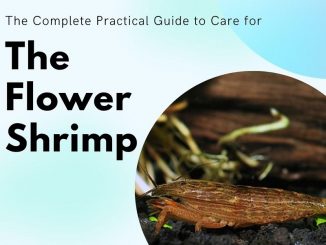
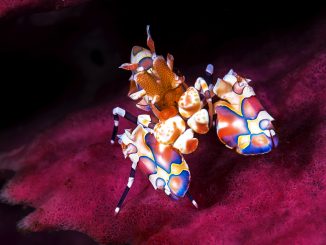
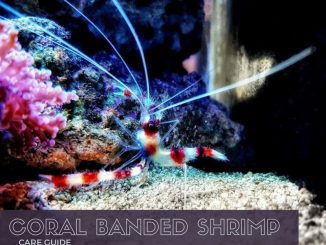
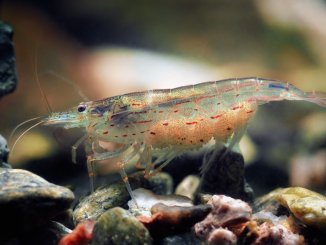
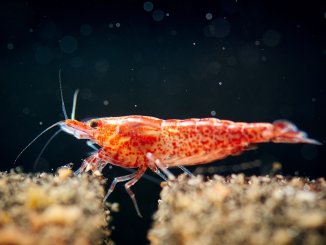
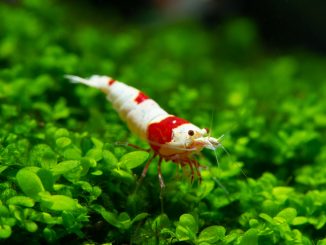
I have just got a vampire shrimp and after 2 days
It seems to be on its side not moving a lot
In the middle of the tank
Is he stuck in a molt ?